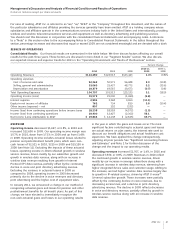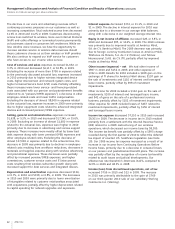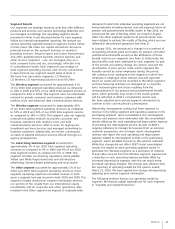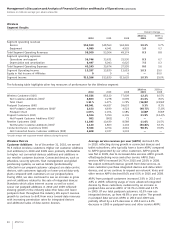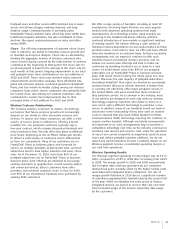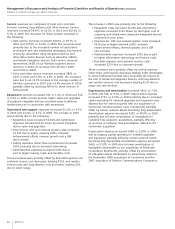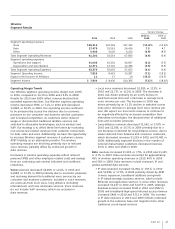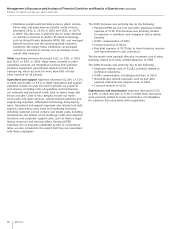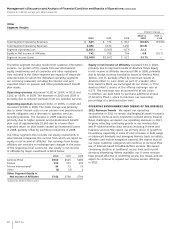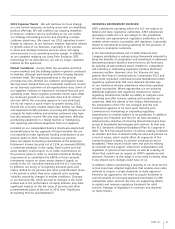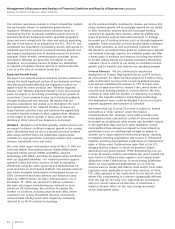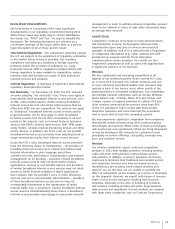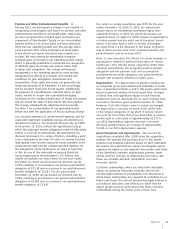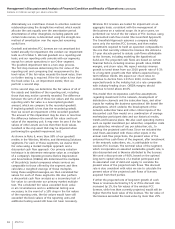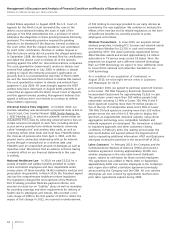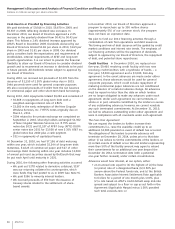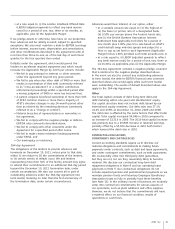AT&T Wireless 2010 Annual Report Download - page 43
Download and view the complete annual report
Please find page 43 of the 2010 AT&T Wireless annual report below. You can navigate through the pages in the report by either clicking on the pages listed below, or by using the keyword search tool below to find specific information within the annual report.
AT&T Inc. 41
OPERATING ENVIRONMENT OVERVIEW
AT&T subsidiaries operating within the U.S. are subject to
federal and state regulatory authorities. AT&T subsidiaries
operating outside the U.S. are subject to the jurisdiction
of national and supranational regulatory authorities in the
markets where service is provided, and regulation is generally
limited to operational licensing authority for the provision of
services to enterprise customers.
In the Telecommunications Act of 1996 (Telecom Act),
Congress established a national policy framework intended to
bring the benefits of competition and investment in advanced
telecommunications facilities and services to all Americans
by opening all telecommunications markets to competition
and reducing or eliminating regulatory burdens that harm
consumer welfare. However, since the Telecom Act was
passed, the Federal Communications Commission (FCC) and
some state regulatory commissions have maintained certain
regulatory requirements that were imposed decades ago
on our traditional wireline subsidiaries when they operated
as legal monopolies. Where appropriate, we are pursuing
additional legislative and regulatory measures to reduce
regulatory burdens that inhibit our ability to compete more
effectively and offer services wanted and needed by our
customers. With the advent of the Obama Administration,
the composition of the FCC has changed, and the new
Commission appears to be more open than the prior
Commission to maintaining or expanding regulatory
requirements on entities subject to its jurisdiction. In addition,
Congress, the President and the FCC all have declared a
national policy objective of ensuring that all Americans have
access to broadband technologies and services. To that end,
the FCC delivered a National Broadband Plan to Congress in
2010. The FCC has issued dozens of notices seeking comment
on whether and how it should modify its rules and policies on
a host of issues, which would affect all segments of the
communications industry, to achieve universal access to
broadband. These issues include rules and policies relating
to universal service support, intercarrier compensation and
regulation of special access services, as well as a variety of
others that could have an impact on AT&T’s operations and
revenues. However, at this stage, it is too early to assess what,
if any, impact such changes could have on us.
In addition, states representing a majority of our local service
access lines have adopted legislation that enables new video
entrants to acquire a single statewide or state-approved
franchise (as opposed to the need to acquire hundreds or
even thousands of municipal-approved franchises) to offer
competitive video services. We also are supporting efforts
to update and improve regulatory treatment for retail
services. Passage of legislation is uncertain and depends
on many factors.
2011 Expense Trends We will continue to focus sharply
on cost-control measures, including areas such as simplifying
product offerings. We will continue our ongoing initiatives
to improve customer service and billing so we can realize
our strategy of bundling services and providing a simple
customer experience. We expect our 2011 operating income
margin to improve, as our revenues improve. Expenses related
to growth areas of our business, especially in the wireless,
U-verse and strategic business services areas, will apply
some pressure to our operating income margin. In addition,
as we complete readying our Long-Term Evolution (LTE)
technology for its intended use, we will no longer capitalize
interest on this spectrum.
Market Conditions During 2010, the securities and fixed
income markets and the banking system in general continued
to stabilize, although bank lending and the housing industry
remained weak. The ongoing weakness in the general
economy has also affected our customer and supplier bases.
We saw lower demand from our residential customers as well
as our business customers at all organizational sizes. Some of
our suppliers continue to experience increased financial and
operating costs. These negative economic trends were offset
by continued growth in our wireless data and IP-related
services. While the economy appears to have stabilized,
we do not expect a quick return to growth during 2011.
Should the economy instead deteriorate further, we likely
will experience further pressure on pricing and margins as we
compete for both wireline and wireless customers who have
less discretionary income. We also may experience difficulty
purchasing equipment in a timely manner or maintaining
and replacing warranteed equipment from our suppliers.
Included on our consolidated balance sheets are assets held
by benefit plans for the payment of future benefits. We are
not required to make significant funding contributions to our
pension plans in 2011. However, because our pension
plans are subject to funding requirements of the Employee
Retirement Income Security Act of 1974, as amended (ERISA),
a continued weakness in the equity, fixed income and real
asset markets could require us to make contributions to
the pension plans in order to maintain minimum funding
requirements as established by ERISA in future periods.
Investment returns on these assets depend largely on
trends in the U.S. securities markets and the U.S. economy.
In addition, our policy of recognizing actuarial gains and
losses related to our pension and other postretirement plans
in the period in which they arise, subjects us to earnings
volatility caused by changes in market conditions. Changes
in our discount rate, which are tied to changes in the bond
market and in the performance of equity markets, may have
significant impacts on the fair value of pension and other
postretirement plans at the end of 2011 (see “Significant
Accounting Policies and Estimates”).


